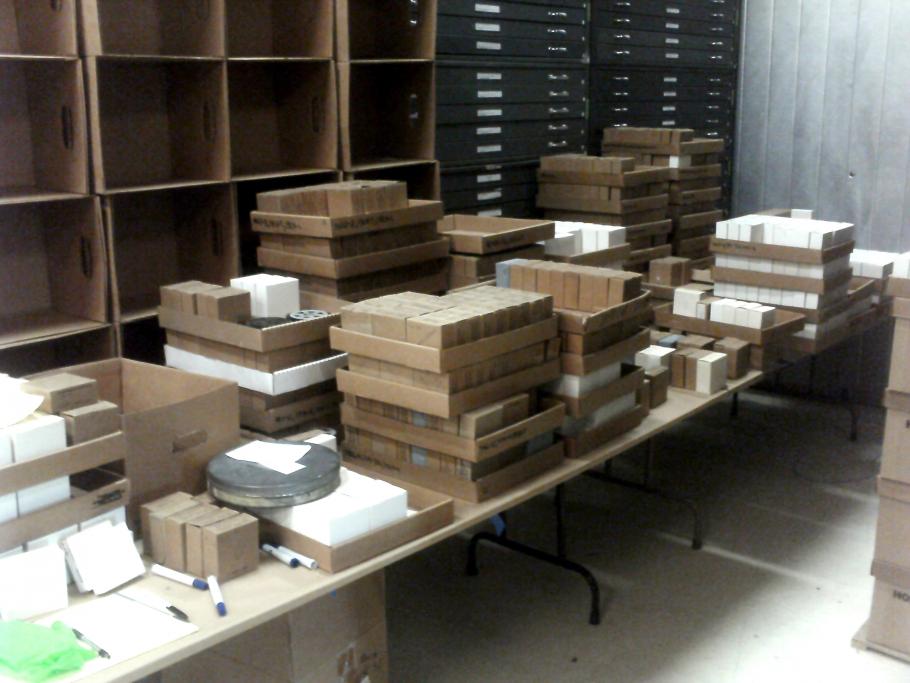Getting ready to move gives you a chance to pull all those old boxes out from the back corners of your closets. You know what's in them - like that box with Uncle Bob's 1970s lime-green polyester leisure suit - but it's always good to double check these things. It's no different when you're preparing to move an archival collection. But first, an historical digression: At the end of World War II, intelligence teams from the Allies went through Europe and Japan looking for scientific and technical developments that might be of interest. Besides retrieving equipment (Operation Lusty) and scientists and engineers (Operation Paperclip), Allied teams gathered and microfilmed documents – hundreds of thousands of documents. Eventually the Air Documents Research Center (ADRC) at Wright Field, Ohio (now part of Wright-Patterson AFB) assembled and indexed 50,000 or so aerospace-related documents as the Captured Air Technical Documents Collection (or CATD) and distributed microfilm copies to a number of research institutions. Flash forward 20 years, when the technology represented by those documents had become less than state-of-the-art. The Defense Documentation Center (DDC), which held a copy of the CATD film, realized that not only was there not a lot of call for the material anymore, but a quarter of all the requests they did receive came from the National Air Museum. After some phone calls, memos, and the like, DDC agreed to transfer their CATD microfilm - lock, stock, and card index - to the Museum. Museum staff sorted the film into two groups - 5,000 or so rolls covered by the card index (and associated "book-style" indexes) and another 3,000 or so rolls of other stuff, mainly duplicates of the first group. By the time I started here 20+ years ago, this second group was still in boxes (about 40 cubic feet or 1.3 cubic meters worth) marked as "Duplicate German-Japanese Film." Now you may be asking (having done some quick math) why was this duplicate stuff sitting on a shelf for 40 years? The answer is a combination of lots of other material needing work, limited staff, and priorities. The CATD microfilm has been research-accessible this whole time. Although dealing with (and disposing of) the duplicate film would free up 40 cubic feet of space, the consistent decision has been to direct our staff efforts to making other parts of the Museum's document collections available. Until now. Since we are preparing to move to the new wing of the Steven F. Udvar-Hazy Center, we have to deal with it. Remember that leisure suit? What if that's not the only thing Uncle Bob stuck in that box? Suppose you look underneath and find great-grandpa's World War I aviator helmet and Great-Aunt Maude's entry form and time sheet from the first "Powder-Puff" Derby?
So, when we pulled those 3,000 rolls of "duplicate" film what did we find? Sure enough, there are those poor-quality diazo duplicates of the ADRC film (read "leisure suit"), but that was only about half of the film. And about half of the rest was good-quality silver duplicates. And the rest? If you're still doing the math, that leaves about 750 rolls. 750 rolls that are not duplicates of anything else in the collection. That's on the order of 750,000 pages. We have a general idea of what's there: documents filmed by Field Information Agency, Technical (FIAT) teams at various German industrial, administrative, and academic sites (although not a complete set of FIAT film); documents microfilmed by the Technical Liaison at Osigo, Italy; Russian technical journals from 1946-1947; additional rolls of Peenemünde records; even some rolls from the main ADRC series that were thought to be missing or lost. But there are no listings, no indexes, no way for us to know specifically what is on any of this film. Yet. But we know it's there now, and that's the first step in making it available. Aren't you glad Uncle Bob saved that box?
